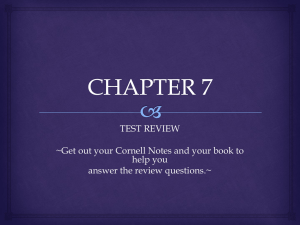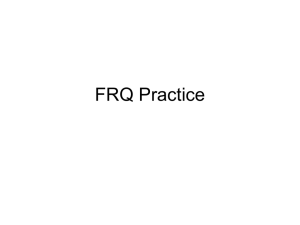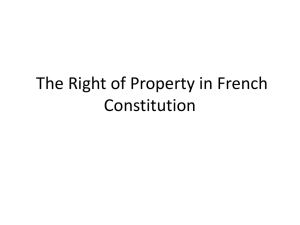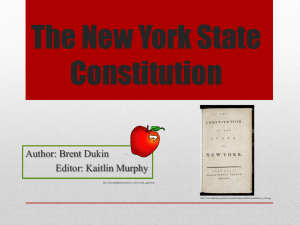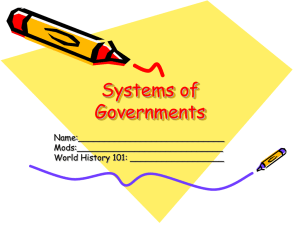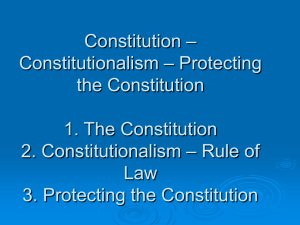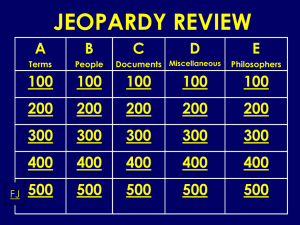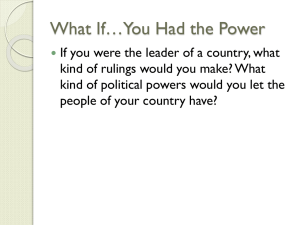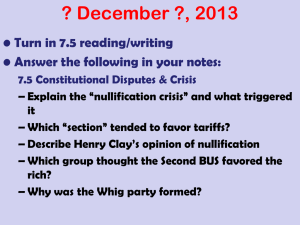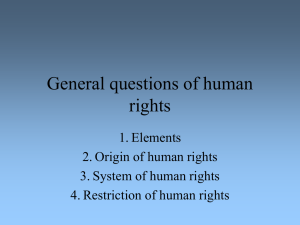I. Constitutional Underpinnings
advertisement
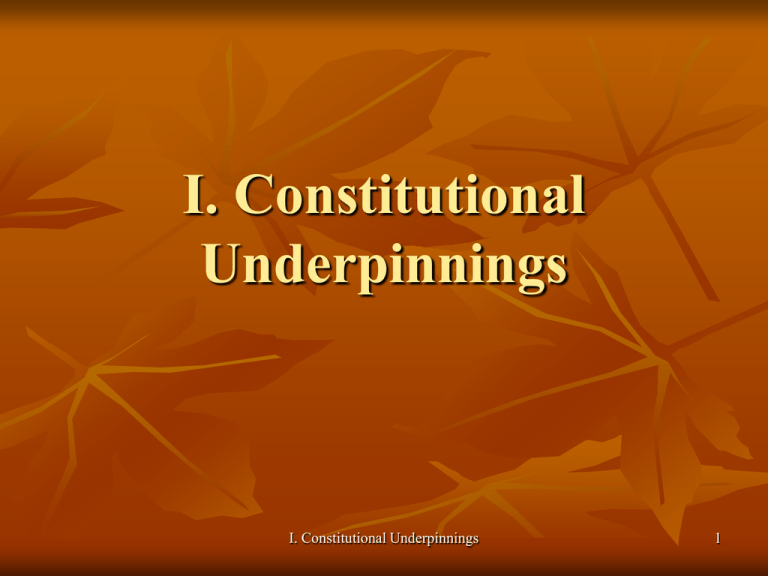
I. Constitutional Underpinnings I. Constitutional Underpinnings 1 A. The purpose of politics Politics is . . . Bag Demo the apparatus that selects our leaders who then fullfill positions in institutions (government) that make policy, using the policymaking system. It is conflictual in nature. . .if one wishes or not wishes to reach a consensus. 1. System - Define democracy – it selects + formulates policy which represents + responds to the public preferences. I. Constitutional Underpinnings 2 a. Theory encompasses: (1) equality in voting (2) effective participation (3) Enlightened understanding - plethora of ideas. . . (4) citizen control of the agenda. (5) inclusion of all who are willing to participate. b. Majority rule w/ minority rights. An issue of “power” . What is a majority . . . (Minority Demo) Majority = An acculumalation of minorities I. Constitutional Underpinnings 3 B. Who really Governs? 4 theories. . . (1) Pluralist theory - competition among groups . . .NRA, NOW, UAW, AARP; seek their agenda. . .Has modern society made these groups less effective? i.e., Putnam. . . (2) Elite + Class Theory - Class splits . . .Big Business rules! (3) Hyperpluralism - Groups divide gov’t, making it ineffective. . . (4) Theory of one. . . I. Constitutional Underpinnings 4 C. Political theorists represent theories 1. Hume - 1734-1750’s - Human nature that man was evil. . .Gov’t by the many with negotiation and compromise promoting a union + eventually establishing a republic. 2. Hobbes - one needs an inherited monarchy to promote the legitimacy of gov’t. Absolutism rules. . .Self interest is nat’l interest > > > Laws = order. 3. Locke - 1689 - social contract theory - Life, liberty and property - Consent of the gov’t by Parliament( few) who had a stake in society because it represented people of property. . .poor people don’t lose much when life deteriorates. Natural rights dominates gov’t rule! 4. Rousseau – Man was corrupted by an evil society. Rule by all - a complete democracy;a community of the whole-Mobacracy - or maybe Direct Democracy. I. Constitutional Underpinnings 5 If one put these 4 on a spectrum, where would they fall? Rousseau Hume Locke Hobbes All Many Few One hyperplurlism plurlism Elite/class Absolute THESIS STATEMENT: Directions: on a 5 X 8 notecard. . .write a topic statement and a minimum of five supporting sentences. . . 10 Minutes Compare and contrast two of the four political philosophers’ ideas (Hobbes, Locke, Rousseau + Hume ) in establishing who governs in a democracy? I. Constitutional Underpinnings 6 Thesis statements Directions: on a 5 X 8 notecard. . .write a topic statement and minimum of five supporting sentences. “The goal of a successful government is to make policy that is legitimate and benefits the masses”. Assess the validity of this statement by explaining (why + how) which political theoriest (Locke, Hume, Hobbes or Rousseau) would provide a more democratic government that would be the most productive in meeting the needs of the masses. 15 points I. Constitutional Underpinnings 7 Underpinnings Thesis statement Directions: on a 5 X 8 notecard. . .write a topic statement and a minimum of five supporting sentences. Many eligible Americans do not participate in the political process. WHY? Which theory, i.e, pluralist, hyperpluralist, elite class theory, or rule of one; are the non participants supporting in this process. Explain theorist (Locke, Hume, Hobbes or Rousseau) would agree with that assessment? 15 points I. Constitutional Underpinnings 8 D. When one governs, one seeks power -Define: Ability to persuade someone else that it is in their (self)ish interest to follow you 1. Power can be distributed three ways in a democracy: (a) power elite - (Hobbes) - Representative Democracy I. Constitutional Underpinnings 9 (b) political elite- (Hobbes + Locke) Participatory democracy (c) majoritarian rule- (Locke or Hume) Direct Democracy d. Mob rule - Rousseau 2. What does one do with power? --Make Policy: - Actions of Gov’t. . . Policy Making Wheel of Fortune I. Constitutional Underpinnings 10 3. How much gov’t should be available. . 1. Liberals vs. Conservative models. . A lot Alittle of govt govt I. Constitutional Underpinnings 11 4. What is the purpose of gov’t; and does it fulfilling its purpose make it legitimate? a. Maintain the social order by: (1) protecting property - “breaking unions”. . . Moving the goods. . . keeping the airlines flying. (2) Right to have militias (3) Economics can take over to make a difference between have and have nots. b. Provide Public Goods: (1) establish infrastructure -- i.e. RR’s (2) Public school system - It took until the New Deal for Feds to truly get gov’t involved. I. Constitutional Underpinnings 12 c. Promote equality . . . 1. Freedom “to” and Freedom “from” unless it compromises someone else’s right (a) of opportunity - go for it, you are the catalyst, It also means competition. Your the mover! Where does that idea fall on the political spectrum? Conservative idea (b) of condition- Since 1960’s (LBJ’s Great Society program-Head Start, Domestic Peace Corps “Some are more equal than others: (Medicare and Medicaid programs) and the Feds will fix the problem. Initiated by the Civil Rights Movement. (c) of Outcome - i.e. Affirmative Action - not just a boost but Gov’t has an obligation to promote minority development. Project evolved from helping the black male to the white female. I. Constitutional Underpinnings 13 Starpower Simulation The following exercise will provide us with some political observations concerning human nature, power, competition and something often referred to as the state of nature. Follow the rules carefully for infractions, either minor or major, will cost you points. This simulation is comprised of three rounds: Trading round Scoring round Bonus round I. Constitutional Underpinnings 14 In this simulation. . .one’s goal is to acculumate points. The more points you have . . .the more power one acquires. ALSO, the more points you acculumate, the higher the GRADE you will acquire. The best score will earn 50 points, the rest will be pro-rated. How does one acculumate points? This is accomplished by trading one’s chips one has selected during the opening round. I. Constitutional Underpinnings 15 Selection Round Step One: Upon entering the room, students MUST be silent. Step Two: Each student will select five chips randomly from the container. Any FIVE chips will do; for at this point the chips hold no value. The student, however, will NOT divulge the contents of their selection to anyone except the instructor. Their selection is secret. Step Three: Display the scoresheet, informing the students the value of their chips. Remember the goal of this exercise is to score points. . .The more points the more power! Some students, because of LUCK, have a lot of points. . .some students DO NOT! I. Constitutional Underpinnings 16 Trading Round Step Four: During this round students will trade chips with each other to score more points. Students currently have five chips in their possession. . .but they can now trade for more chips and eventually collect six, seven or more chips depending upon the effectiveness of their trading. BUT. . .students can only count their best FIVE chips when adding up their points. Trading round rules are: You must hold hands when pursuing a trade No talking unless holding hands ALL trades must be of unequal value. . .i.e. one cannot trade a white chip for a white chip. . .but one can trade a red chip for two green chips. Once a student wishes to stop trading, they fold their arms, Count up their chips, turn them in to the instructor, and write the scores on the board under the proper category. I. Constitutional Underpinnings 17 Bonus Round: Give each group three red poker chips. Each chip is worth 20 points a piece. The groups have 10 minutes to dispense the chips by either giving one student 3 chips = 60 points; two students, one receiving 40 pts and one receiving 20 pts; OR three students receiving a chip a piece worth 20 points. All decisions are must be made by majority rule. IF some students are unruly, they may be momentarily removed from the group by majority vote until the next round begins. Once the red chips have been allocated, change the scores on the board for those receiving the bonus points and hand out the appropriate symbols to each group. I. Constitutional Underpinnings 18 Starpower scoresheet # 0f Chips Gold Green Red Blue White 1 80 40 30 20 10 2 160 80 60 40 20 3 240 120 90 60 30 4 5 320 400 160 200 120/140 150/180 80/110 100/140 40/40 50/50 I. Constitutional Underpinnings 19 D. The bumpy road defining America’s Democracy -American Revolution establishes a new gov’t Define Revolution – e. RESOURCES (1). INTERNAL – Guns OT of Establ Instituttion (2). EXTERNAL - France 2. . Components of a revolution f. Recognition : What will king do? a. People 1) Fight back (2) Surrender (1). LEADER - Philosophers 3) Negotiate 4) do Nothing (2). FOLLOWERS g. MARTYR from Bos Mass – Xmas (a). RADICALS - Sons of Lib Atticus (b). MASSES – at 50 % of Pop h. SPARK - Tea Party; Bost Mass b. THEME- Locke’s model - natural i. PROPAGANDA: - Use or abuse of truth to influence Masses rights, consent of the governed, limited gov’t, standing laws. . . j. MISC. 2. Revolution’s intent: restore rights Live or Die; Give me lib or give me that the king had taken away from death ; Ta x w/o Representation us. . . Declaration of Indep! c. CAUSE -Dec of Indep had 27 of its ideas listing the evil deeds of the king. d. Oppressor - King Grge IIII.or Parlia Underpinnings Constitutional 20 1. D3 Articles of Confederation A Victory brings a New Gov’t 1) Why did the framers choose a confederation? a) Unitary system provided a tyranical parliament b) Each state was unique. . .they wanted . . . Sovereignty b. Strengths + Weaknesses 1). What could it do 2). And worse. . .what couldn’t it do. . . 3. Shay’s Rebellion showed its true weaknesses Economic strife showed the national gov’t couldn’t protect its citizens. a. I. Constitutional Underpinnings 21 Freedom House Research 1. This "Most Repressive Societies..." report is available online at http://www.freedomhouse.org/template.cfm?page=13 8&report=40 2. There's also a map of "Freedom in the World" on its web site at http://www.freedomhouse.org/template.cfm?page=20 &year=2005 3. and a "Map of Freedom of the Press" at http://www.freedomhouse.org/template.cfm?page=16 &year=2005 4. Freedom House also has a web site for the "Center for Religious Freedom" at http://www.freedomhouse.org/religion/ I. Constitutional Underpinnings 22 Liberal v. illiberal Democracies Liberal democracies possess substantive and procedural democracy characteristics Illiberal or managed democracies only possess only procedural characteristics. Procedural. . .Talks like a democracy. . .but does not practice the substantive characteristics of . . Free elections, civil liberties. . .free press. . .checks and balances. I. Constitutional Underpinnings 23 4. The Constitution The new constitution needed to answer 5 Q’s. . . a) How should the gov’t rule b) Who should rule c) How will the people participate equally? d) How keep factions into establishing a tyranical environment? e) How keep gov’t from becoming too tyranical? – I. Constitutional Underpinnings 24 5. Six Constitutional Principles f. Judicial review Constitutional check on executive and Legislative powers by the federal courts, who eventually will receive this jurisdiction. Marbury v. Madison I. Constitutional Underpinnings 25 6. Constitutional resolutions - Appealing to the “Factions” or self-interests of Americansslave owners to small town shopkeepers. . . Madison’s Federalist papers # 10. . . Compromises resolved that: a. Equality 1)Representation (REPUBLICAN) - New Jersey Plan (= represent) v. Virginia Plan (prop. representation ) led to Connecticut Compromise: US Senate ( 2 Senators per state) US House - (Reps per population 2) slavery - South wanted all males counted; Three-fifths compromise. - A show stopper 3) North South Trade agreement … no export taxes. b. Who can vote - Property owners vs. disenfranchised. States set election laws. c. Economics - Congress shall rule + it will build the infrastructure (Post offices to taxation- Article I) I. Constitutional Underpinnings 26 d. Individual rightsConstitution lacked in this area- show stopper although the Consti did say: 1) Writ of habeas corpus 2) bill of attainders 3) ex post facto laws 4) religious preferences to hold office 5) treasonous offenses 6) trial by jury But were we being ruled by “men” or by laws . . . to protect us from these “men” the Bill of Rights was added to protect us from gov’t. . .a recollection of all the ills that the colonists resided under British rule. NOTE: B of R HO I. Constitutional Underpinnings 27 D7. Popular sovereignty and the stress on individualism once again came to the forefront. Federalists v. anti-feds. Big gov’t v. small gov. 8. Madison declared that the factions will take care of themselves in a true democracy. . . self interest will turn into national interest. . . But a B of R was needed to protect one from the nat’l gov’t. I. Constitutional Underpinnings 28 D9. How prevent tyranical gov’t? Separation of powers between branches of gov’t. – Montesquieu theorized that the climate controls behavior. . .so control the political climate by limiting what each gov’t sector can do. b) Have each branch of gov’t “check” the other to establish a “limited” gov’t. The Spirit of the Laws. a) I. Constitutional Underpinnings 29 10. Ratification - States voted- - -only needed 9 states to ratify (A of Confed needed unanimous approval to amend) a. Federalists v. Anti-feds (1) issue -- the 2nd Consti was a “class-based document that benefited only the economic elite! (2) fundamental liberties! Were the Bill of Rights enough? 3. Federal $$$$$. . .diminishes State $$$$$. Result - State special conventions would ratify, not state legislators I. Constitutional Underpinnings 30 11. “Changing” the ConstitutionAmendment Process a. Formal process (1) proposal - 2/3 of each Congr or National convention (2) ratification - 3/4 of state leg or spec convention i.e. ERA was proposed by not ratified! (3) - 27 Amendments - taxation to congressional salaries I. Constitutional Underpinnings 31 b. informal process(1) Federal court decisions - Marbury v. Madison (2) Changing political practices - Dems v. Reps Liberals v. Conservatives (3) Domestic politics to foreign politics. Policy makers carry big sticks in implementing policy. “police actions” to “role of gov’t. . . I. Constitutional Underpinnings 32 E. Federalism - a decentralization of gov’t. -- a “sharing of the wealth” + gov’t power. 1. Distribution of power. Federalism Nat’l Gov’t State Gov’t Delegated Powers Reserved Powers Concurrent I. Constitutional Underpinnings 33 a. Delegated powers Feds rule – Declare war, border security (1) INHERENT – all gov’t possess these pwrs. . .immigration, Foreign policy (2) Expressed -- (enumerated) Stated specifically . . .Congress makes laws (3) Implied (Makes expressed powers work) – Congress establishes a civil service system to hire federal workers. I. Constitutional Underpinnings 34 b. Concurrent - shared power. i.e. education, taxation c. reserved - states rule - welfare, local education control, local gov’ts, professional licensing. 2. Who shall rule in conflict - Art VI- Supremacy Clause - and Implied powers of national gov’t upheld with McCullogh v. Maryland. 1819, banking issue set forth the “elastic clause” that gave the Congress the Necessary and Proper powers (implied powers) to enact policies to run the country! I.e. YUCCA MT SCENARIO I. Constitutional Underpinnings 35 Federalism thesis a. b. The framers idea for a new government settled on a federal format, as addressed by Dr. Sheffield. Explain why the framers made such a decision. Identify five federal threads that still weave through America’s political fabric today. I. Constitutional Underpinnings 36 Federal Threads. . . a) b) c) d) e) f) g) h) i) Issue of Sovereignty . . .people controlled both fed + state gov’t. Supremacy clause (Art VI) gave pwr to Fed govt Constitutional amendments cannot occur w/o state ratification. Art V Feds dictate civil lib + civil rights. Voting + Elections of Reps Representations of Reps by state. Electoral College If a tie. . .states elect federal officer I. Constitutional Underpinnings 37 Judicial selection. . .senatorial courtesy. State retain power unless . . . 3. If not stated- states have the rights – Stated??? 10 Amend! 4. Commerce power - Gibbons v. Ogden . Interstate + internat’l commerce . Congress rules! I. Constitutional Underpinnings 38 5. Full Faith and Credit clause - One state’s validity carries over state borders - i.e. marriage licences. Today’s issue - Homosexual marriages and insurance coverage. The courts may decide . . . 6. Privileges + Immunity clause . . . Citizens of one state will not be discriminated when they visit another. . .sales tax for only tourists>>> nope. . .but what about out of state tuition? Or only residents can vote in elections? Court has been unclear. I. Constitutional Underpinnings 39 6. From Dual to cooperative federalism - a. Education sets the stage for both the Feds + states to work together in “fiscal harmony” b. “Shared Costs” of Fiscal federalismWhy use federal help at the “expense” of state sovereignty? (1) Feds had the bucks. . . surpluses abounded (2) Fed income tax in 1920’s (3) Feds could print more if needed more (4) Politics - States saw it as “free”money. Why not pursue it. . .Constituents benefitted! I. Constitutional Underpinnings 40 c. Grant-In-Aid programs been around for 200+ years. Feds sell land to fund programs! d. Categorical grants - specific $$ for specific projec w/ strings attached. . .non-discrimatory - Cross cutting requirements - Offenders lose it all! (1) Project grants - NSF - competitive requests (2) Formula grant- Do you meet the formula. i.e. public housing, employment programs I. Constitutional Underpinnings 41 e. Block grants - social service endeavors w/ less strings attached. SIGS pursue the $350 billion f. Mandates - Feds dictate specific guidelines. . .if don’t comply, penalized or lose the funding. . . Special ed, Disability Act, Clean Air. . .Medicaid (a) unfunded mandates. . .Laws w/o funding. . . (b) Printz vs. US claimed forcing sheriff’s departments to pursue gun permits w/o fed $$$$ was unconstitutional. . .but unfunded mandates still occur today. I. Constitutional Underpinnings 42 g. Not all states are treated equally. . . when it comes to fiscal federalism. . . its the role of the politician to take care of ones constituents! With a $3 trillion budget, there is plenty to fight for! h. More and more responsibility is falling upon the states to address funding issues . . .Devolution. I. Constitutional Underpinnings 43 i. Devolution 1. Federal gov’t is sending less and less money down to the states. 2. Welfare to Work Reform act of 1996. . . 3. Feds cutting welfare benefits, forcing states to move people off welfare rolls. j. Federalism issues today: a. NCLB b. Yucca Mt c. Gay Marriage d. Eminent Domain e. Legalizing MJ f. Teri Schaivo. . . g. Patriot Act h. Balance the budget Amendment. i. Overrule Congress legis by 2/3. I. Constitutional Underpinnings 44 Exam Chap 1-3 Review Practice Essay . . . I. Constitutional Underpinnings 45 Rubric 3b. Limited government is one of the key principles found in the Constitution. It allows for checks by the people and also allows for checks by the government itself. a. Identify and explain two examples of how government is limited by the people themselves. b. Identify and explain two examples of how the Constitution limited the government itself. c. Explain how the Federalists and Anti-Federalists both incorporated the idea of limited government in their philosophical goals. a.Students must be able to express that government limited by the people means self- government: a government subject to the preferences of the majority. This would include indirect systems of popular elections of representatives and preferences of the majority in vote’s in Congress and the Supreme Court. b. Students must understand how the Constitution provides for a limited national government mainly by its separation of powers and checks and balances. The Constitution, with its Bill of Rights, also prohibits government from infringing on individual rights. Judicial review is an additional safeguard of limited government. The book also discusses grants of powers and denial of powers. c.Students should be able to explain how both the Federalists and Anti-Federalists agreed that the national government should be limited: A single executive with reduced powers; check and balances and separation of powers; federalism and a Bill of Rights.
